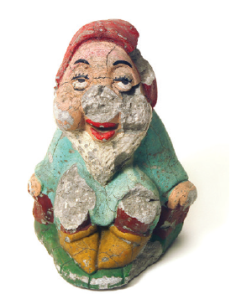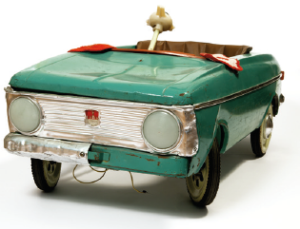Museum of Broken Relationships
PRE-ORDER
THE MUSEUM OF BROKEN RELATIONSHIPS
ABOUT THE AUTHORS
What's Inside
Introduction
Olinka Vištica
I still remember fragments of that scorching summer more than a decade ago, when love slowly gave way to pain. In a house that seemed to have already been split down the middle, we took to sitting almost without speech at the kitchen table trying to overcome the feeling of loss and quietly surrender to the end of love. When we spoke, we spoke gently as if trying not to disturb the bandage on a newly opened wound. The physical remains of our four years together gawked at us from every corner of the house: a dusty desktop computer laden with photographs of happier times, books inscribed with dedications and failed promises, a VHS player that had witnessed cuddly movie nights long before the digital age. Even the kitchen table we sat at was loaded with meaning and memories that were doomed to fade away along with our shattered relationship.
 What can one do with the frail ruins of a love affair? If you enter the phrase broken relationship into any search engine, in any language, you will be offered a series of self-help instructions describing how to unload your emotional burden as quickly and efficiently as possible. Self-proclaimed experts want to tell us how to get rid of every merciless reminder of our washed-out love, of yet another defeat, of yet another personal failure. Libraries and virtual space are flooded with advice for attaining oblivion. But is total erasure the only way out?
What can one do with the frail ruins of a love affair? If you enter the phrase broken relationship into any search engine, in any language, you will be offered a series of self-help instructions describing how to unload your emotional burden as quickly and efficiently as possible. Self-proclaimed experts want to tell us how to get rid of every merciless reminder of our washed-out love, of yet another defeat, of yet another personal failure. Libraries and virtual space are flooded with advice for attaining oblivion. But is total erasure the only way out?
In the midst of the debris surrounding us, there was one trivial object that, in its own unlikely way, glued the shards of memory back together. We used to call the little windup toy honey bunny—a substitute for the pet we could never have, since we both traveled so often, and Dražen is allergic to cats. Now this banal symbol of the transient nature of our relationship seemed to offer an answer. That fluffy toy used to bring a smile to my face every time I came home exhausted from work to find it cheerfully marching in circles in the entryway. It became the first building block of the project that, miraculously, still ties us together. We came up with a simple idea: a place to store all the painful triggers of past loves, creating a vault for both their tangible and intangible heritage. It seemed a nicer, more poetic solution than divvying up family possessions or, worse, giving in to outbursts of emotional vandalism, which would be bound to destroy invaluable parts of our intimate history. We named this repository the Museum of Broken Relationships.
Our museum was first introduced to the public in 2006 as an installation at a local art festival. A stranded ship container served as a harbor for forty objects of love's wreckage. The objects had been entrusted to us by both close friends and complete strangers, and we displayed them anonymously—the personal stories of their owners were the only text. Stories that had once had meaning to only two souls immediately resonated with an audience, strangers who recognized that heartache all too well. Soon thereafter, we were invited to set up installations in Berlin, San Francisco, Ljubljana, and Singapore and found ourselves venturing wholeheartedly on a thrilling journey down memory lane with no final destination in sight.
Our own breakup snowballed into what might easily be the most meaningful thing we ever created: an ever-evolving global collection of keepsakes, trinkets of no objective value, each of them a precious witness to the end of a relationship.
In the years since, I have lost count of how many parcels stamped in Europe, India, China, Australia, or the United States (to name just a few of their places of origin) we have personally opened. At this point, thousands of objects have been wrapped and carefully tucked into padded envelopes by anonymous hands, most of which we will never have the honor of shaking in recognition, greeting, and gratitude. After more than forty amazing exhibitions in twenty countries, even after the establishment of museums with permanent addresses in Zagreb and Los Angeles, we still find ourselves puzzled whenever an unknown storyteller, from some near or distant patch of the planet, chooses to bid farewell to their love by sending their keepsake into exile, to a safe place for public commiseration.
 Whatever their motivation for donating personal belongings—be it therapeutic relief, sheer exhibitionism, or a desire to immortalize the otherwise impermanent—people have embraced the act of exhibiting their emotional legacy as a sort of ritual, a solemn ceremony. Our society acknowledges marriages, funerals, and even graduations but denies us any formal occasion to recognize the demise of a relationship—despite the power that a breakup has to disrupt, or even shape the course of, a life. Thus, sending the object to the Museum of Broken Relationships has become almost a cathartic ritual, a final act in a person's process of coping with loss. The donors release their stories to us with the hope that their intimate confessions will resonate in the hearts of museum visitors; but what they may not suspect is the comfort and relief their stories offer to those who read them. A mundane object and its story, displayed in a public space, create a temporary comradeship of complete strangers, and it feels like magic. It is magic.
Whatever their motivation for donating personal belongings—be it therapeutic relief, sheer exhibitionism, or a desire to immortalize the otherwise impermanent—people have embraced the act of exhibiting their emotional legacy as a sort of ritual, a solemn ceremony. Our society acknowledges marriages, funerals, and even graduations but denies us any formal occasion to recognize the demise of a relationship—despite the power that a breakup has to disrupt, or even shape the course of, a life. Thus, sending the object to the Museum of Broken Relationships has become almost a cathartic ritual, a final act in a person's process of coping with loss. The donors release their stories to us with the hope that their intimate confessions will resonate in the hearts of museum visitors; but what they may not suspect is the comfort and relief their stories offer to those who read them. A mundane object and its story, displayed in a public space, create a temporary comradeship of complete strangers, and it feels like magic. It is magic.
We have often been asked if donating an object to the museum could be considered a kind of therapy for the donors and the museum visitors alike. Although we have witnessed people connecting, even in the most unexpected ways, with others' experiences and finding consolation in their grieving, we nonetheless shun the word therapy. It implies illness, the idea that there is something wrong with us that needs curing, as if simply taking the right pill would do the trick and fix everything.
 We live in an era when something as complex, miraculous, and vital as a human encounter is often reduced to a status advertised on Facebook. We publicly display photographs of ourselves smiling, contented, bursting with optimism—almost as if we were trying to convince ourselves of their authenticity. Solitude, on the other hand, doesn't fit neatly into our social media. No wonder it rarely finds expression there. The complexity of its value defies conversion into an exact number of likes. The melancholic beauty that emerges from the rifts we experience during the course of our lives has been unjustly banished from the public conversation, in the same way that bags and wrinkles are erased by a Photoshop brush. We are left with an image of life that is nothing more than a touched-up portrait of happiness.
We live in an era when something as complex, miraculous, and vital as a human encounter is often reduced to a status advertised on Facebook. We publicly display photographs of ourselves smiling, contented, bursting with optimism—almost as if we were trying to convince ourselves of their authenticity. Solitude, on the other hand, doesn't fit neatly into our social media. No wonder it rarely finds expression there. The complexity of its value defies conversion into an exact number of likes. The melancholic beauty that emerges from the rifts we experience during the course of our lives has been unjustly banished from the public conversation, in the same way that bags and wrinkles are erased by a Photoshop brush. We are left with an image of life that is nothing more than a touched-up portrait of happiness.
The objects presented in this book are far from touched-up. Ranging from the banal to the bizarre, they capture authentic snapshots of human experience from around the world over the last hundred years, often set against the political, ethical, and social challenges of the times. Whether the protagonists of these stories are engaged in battles across tiled kitchen floors or war-torn Afghan deserts, their stories never fail to enchant us. Each object's gripping power lies precisely in its rawness, in the courage and honesty of its former owners who chose to shed some light on the miraculous ways we love and lose. These diverse, often elliptical narratives span a gamut of emotions, from wry humor to deep grief, and they continue to provide a humbling experience, a source of inspiration, and a reminder to value those moments of true connection with each other, however brief or distant in the past they may be.
Contrary to its evocative title, the Museum of Broken Relationships is full of life, yearning, and hope. It is a tribute to the resilience of the human spirit, which is, luckily and amazingly enough, almost always ready to give love a new chance.



 Olinka Vištica is an arts producer, born in Split, Croatia, and cofounder of the Museum of Broken Relationships. She holds master’s degrees in English and French language and literature from the Faculty of Humanities at Zagreb University.
Olinka Vištica is an arts producer, born in Split, Croatia, and cofounder of the Museum of Broken Relationships. She holds master’s degrees in English and French language and literature from the Faculty of Humanities at Zagreb University.






